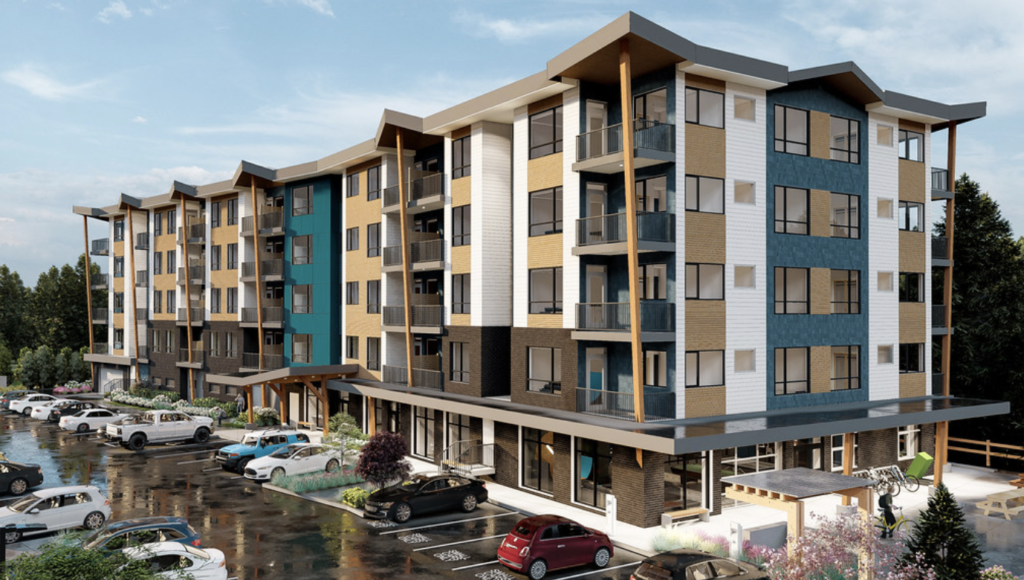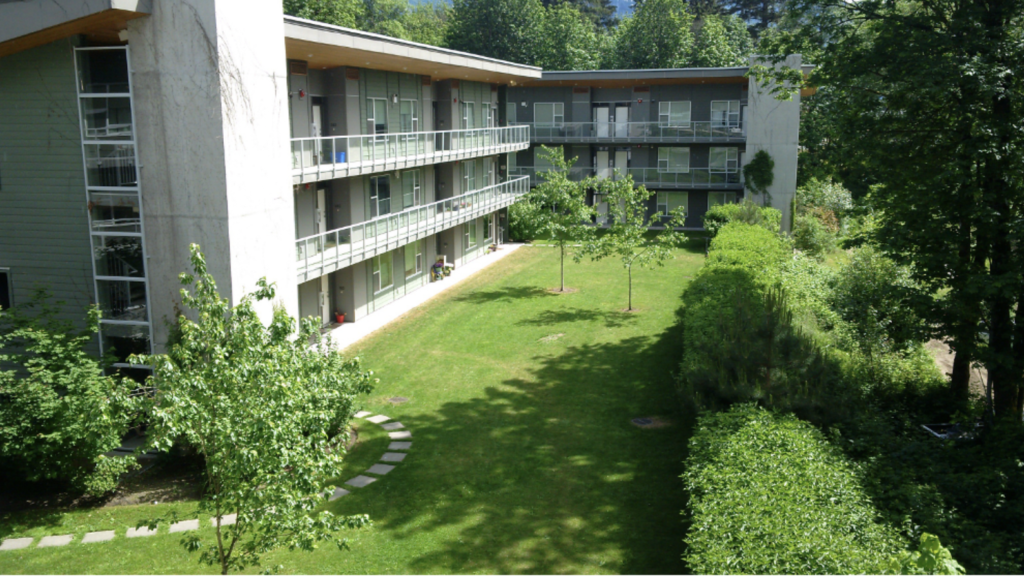District’s housing policy is aggressively called “Affordable Housing Strategy and Action Plan”; at least 372 new units are in pipeline

(By News Desk)
As the first two units of purpose-built affordable housing in Gibsons become available, 155 units have been achieved in the District of Squamish (population just over 20,000) in recent years. Another 372 are in the pipeline.
Centrepoint Apartments has 32 studio, one-bedroom and two-bedroom units that range in price from $985 – $1,450.
The Riverstones building has 83 one-bedroom plus den and two-bedroom affordable homes. Fifty-three are below-market units and 30 have a rent level that is geared to a tenant’s income.
Castle Rock Family Housing is made up of 40 two-, three- and four-bedroom townhomes which are subsidized for families with children under 18.
Ground has been broken for another 76 units of affordable and deep subsidy housing on District land at Buckley Avenue, available in the Summer of 2022.
The five-storey building will have 12 studio units, 48 one-bedroom units and 16 two-bedroom homes with rents ranging from approximately $1,675 for a one-bedroom to $2,500 for a three-bedroom.
The studio’s and one-bedrooms are subsidized for tenants with an income less than $18,825. The two-bedroom unit are subsidized for people with an income below $26,400.
At another location in Squamish 232 units of affordable senior one-bedroom housing are being built, and 64 purpose-built affordable rental units are in the permit stage.
Since last November, 75 people at risk of homelessness have a home at Under One Roof, a mix of emergency shelter, transitional and supportive housing with a Food Bank.

The District’s affordable housing policy, aggressively called the “Affordable Housing Strategy and Action Plan,” contains a number of measures to facilitate the construction of affordable housing.
One of them is fast-tracking approvals for affordable housing projects.
To keep rental units available in the community, the District is enacting a zoning bylaw that can lock properties with rentals into new rental buildings if redeveloped.
The District partners with non-profits to get affordable housing built.
The Buckley Avenue project is a partnership between the District and Eighth Avenue Development Group through BC Housing’s Housing Hub program.
The provincial government provides low-cost financing through the Housing Hub to encourage developers to build new rental homes instead of condominiums for sale. The province is contributing approximately $23.6 million in low-cost construction financing for the project, which developers will pay back.
BC Housing will provide an annual operational grant to cover the difference between the rental revenue for the building and the costs to operate it. No local tax funds are proposed to support the project.
The District’s Affordable Housing Strategy and Action Plan states that affordable housing units need to be financially sustainable and not require ongoing taxpayer operational subsidies or funding.
Sea to Sky Community Services will operate the Buckley Avenue building.
To ease its workload, the District intends to set up an arms-length governing body for affordable housing. Hopefully, it will be formed this year, Mayor Elliott told The Coast Clarion.
In 2018 the District changed the zoning bylaw so that supportive and transitional housing is allowed in all areas of Squamish. This kind of housing does not need to go to a public hearing and there is no discussion with NIMBY’s, mayor Karen Elliott explained. “Housing is a human right in Squamish.”
District land is used for supportive and transitional housing, and fees and services are waived.
In the Spring of 2020 it was clear that a number of people were in need of the kind of housing Under One Roof would provide but the building would not be finished until November.
The District got together with BC Housing for funding for a temporary solution. Local companies provided used Atco’s — work camp units — to house 50 people from May until November. After Under One Roof opened, the Atco’s were moved to the Mainland to be used again as shelters.
The Food Bank in Under One Roof is stocked with food which is donated by local businesses.
It’s great that Squamish is doing this. But if $985 or $1400 a month is considered “affordable” these days that leaves a lot of people out–not just people on welfare but low income seniors and the working poor.
The model evidenced by Squamish is certainly one we need to pay attention to. It’s inspirational in that it demonstrates what can be accomplished with political and social will.
Rent has to be tied to earnings